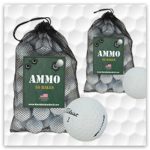Impact of Altitude on Golf Ball Performance: Tips for High Elevation Play
Have you ever experienced the thrill of watching your golf ball glide effortlessly through the crisp, thin air of a high-altitude course? While the extra distance might feel like a stroke of luck, it’s actually the result of physics that demands careful thought. Elevation can have a profound impact on golf ball performance, making it essential to understand these effects to maintain your performance.
High Elevation Golf Ball Performance Summary:
- High altitude impacts golf ball performance by reducing air density, which increases distance but decreases control and predictability.
- Choosing mid to high-compression golf balls and adjusting club selection are key strategies for optimizing play at high altitudes.
- Preparing for high-altitude golf requires acclimation, mindful breathing, staying hydrated, and adjusting your pace to maintain energy and focus.

How Altitude Affects Golf Ball Performance
At high altitudes, the air is thinner, resulting in reduced air density for your golf ball to navigate. With less resistance, the ball can travel farther, offering an advantage for players aiming for extra yardage.
However, this benefit comes with a trade-off: the lower air density can make your ball’s spin and trajectory less predictable. Shots may fly straighter, but they can be harder to control. Understanding these nuances is essential to mastering the distinctive challenges of high-altitude golf.
High Altitude Golf Ball Quick Reference
- Air Density: Thinner air reduces drag, increasing ball distance.
- Spin & Trajectory: Lower air density decreases spin, making shots straighter but harder to control.
- Club Selection: At high altitudes, your shots will go farther because the air is thinner, so you can use a shorter distance club than you normally would for the same distance.
Find The Best Golf Balls

Recommended:
- DIY Golf Ball Testing: How to Evaluate Performance on the Course
- Best Golf Balls for Beginners: Expert Recommendations and Player Reviews
- Golf Ball Pack Size: How to Choose the Right One
Choosing the Right Golf Ball for High Altitude Play
The golf ball you choose can significantly impact your performance when playing at high altitudes. Low-compression golf balls, which are designed to compress more easily, might not perform as well in thin air since they’re already designed to maximize distance. Instead, look for mid to high-compression balls that offer better control and spin.
Brands like Titleist, Callaway, and TaylorMade offer options that cater to these needs. Experiment with a few different types before your round to see which one complements your playing style at elevation.
More Reading:
- The Best Golf Balls for Seniors: Enhance Your Game in 2024
- Supercharge Your Game: How to Choose the Right Golf Ball for Different Courses
- Best Golf Balls to Buy in 2024
Adjusting Your Playing Strategy at High Altitudes
With the increased distance that comes from playing at high altitude, it’s essential to adjust your club selection. You might find yourself using a shorter distance club than you normally would for the same yardage.
Additionally, because the ball flies straighter, you may need to recalibrate your aim, especially on doglegs or when trying to shape shots. It’s also crucial to adjust your expectations—what works at sea level might not be as effective at 7,000 feet.
Take the time to hit a few extra practice shots to get a feel for how your clubs perform in these conditions.
Gift Cards Are Always A Perfect Gift
Practical Tips for High Elevation Golf
Playing at high altitudes requires more than just adjusting your equipment and strategy—it demands thoughtful preparation and awareness of your surroundings. Here are some practical tips to help you make the most of your high-altitude golf experience:
- Acclimate to the Altitude: Spend a few days at high elevation before your round to allow your body to adjust. This can help prevent fatigue and ensure you’re playing at your best.
- Monitor Your Breathing: The thin air at high altitudes means you’ll need to be mindful of your breathing. Take deep, steady breaths to maintain focus and energy throughout your game.
- Stay Hydrated: Dehydration happens more quickly at higher elevations, so drink water regularly during your round to keep your energy levels up.
- Use the Wind to Your Advantage: Wind conditions can be more variable at higher altitudes. Pay attention to the direction and strength of the wind, and use it to help guide your shots when possible.
- Warm-Up Thoroughly: The cooler temperatures at high elevations can make muscles stiffer. Spend extra time warming up to ensure your body is ready for the demands of the round.
- Mind Your Pace: Walking or carrying your bag at high altitude can be more tiring than at sea level. Take it slow, especially on steep inclines, to conserve energy for your swings.
- Keep Snacks Handy: The reduced oxygen at high elevations can affect your energy levels. Carry light, high-energy snacks like nuts or fruit to stay fueled throughout the round.
Also Interesting:
- Navigating the Golf Ball Rollback: Implications and Insights
- Golf Balls In The Cold And Why Your Golf Balls Behave Differently
- Understanding Golf Ball Compression: A Guide for Optimal Performance on the Course
Final Thoughts On High Altitude Golf Ball Performance
High-altitude golf is both a challenge and an adventure, offering unique opportunities to refine your game. Understanding the effects of elevation on your golf ball and making thoughtful adjustments to your approach can help you excel in these conditions. Every course has its own character, and high-elevation courses are no different. By embracing the experience and experimenting with your strategy, you might just discover that high-altitude rounds become some of your most enjoyable on the greens.
Writer/Editor: Danny Kapp is a passionate golf enthusiast and an 8-year veteran golf blog writer for Rock Bottom Golf, offering his unique perspective on the game. With a keen eye for detail, he covers various aspects of golf, ranging from technical insights to the latest trends in golf equipment and golf technology.










Pingback: Best Golf Balls for Fall: Best Picks for Cooler Weather Performance
Pingback: How to Hit Longer Drives in Winter: Tips & Tools for Cold Weather